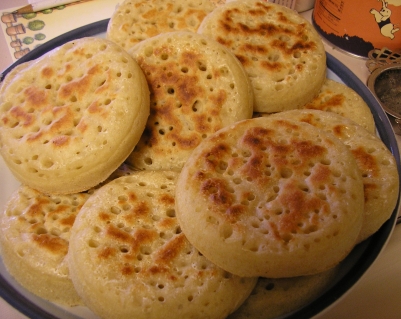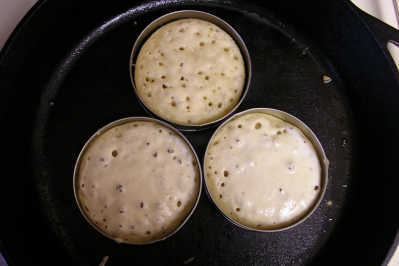
My mom's next Big Hope for crumpets was our trip early last year to Bath, England, where the owner of a bakery told my mother that "No one in England makes crumpets anymore. It's too much work. You can only get the ones they sell in stores". That is a bit hard to believe, but we kept checking bakeries and didn't find anyone who sold them. Freshly made crumpets are a world apart from the rubbery disks they sell in supermarkets, so my mom was very disappointed, because she had been talking more excitedly about getting crumpets than about anything else we might see or do in England.

So, when I came across a crumpet recipe in one of the first books I borrowed from the library on baking bread, I decided I'd make it. That's when my mom told me that my grandmother and several other relatives, all of whom are accomplished cooks and bakers, had tried and failed to make crumpets. Hm. I was daunted, but kept going on about cast iron griddles (necessary for making crumpets, and what my pappy (maternal grandfather) used to make the best pancakes I've ever had) until my mother finally bought me one. I said I thought the crumpet recipe looked like it would work, so my mom bought me English muffin rings and I tried everything out once when everyone was out. (I cook and bake best when no one is around.)
I lost my first batch of four crumpets for a couple reasons:
1. I had the skillet too hot, so the bottom burnt before the rest cooked through.
2. I hadn't greased the skillet, because the recipe said not to, but you really should.
3. The four crumpet rings took up so much room, I couldn't maneuver a spatula to flip them.
Those first four went down the garbage disposal, but the batter was nice and bubbly, like the recipe said it should be, so I tried it again, two at a time, at a lower temperature, and they worked fine.

My mother and sister were leaving to visit family on Christmas day, and I said I'd make them crumpets to take along for my grandma and aunt, since they missed having good ones. I had promised to make stollen for Christmas breakfast too, and at 5am when I finished that, I realised I'd have to stay up all night to get the crumpets done in time for mom to take on her noon flight. The only problem: we'd run out of yeast and everything was closed for Christmas. After thinking about it for a little too long, I finally came up with the idea of borrowing some from the neighbours whose cats I'm watching. I found it after a short walk in the cold and a brief search, but when I got home again, I noticed we were out of all purpose flour. We have loads of bread flour and at least five or six other kinds, but were out of the normal stuff. How very typically me. So it was back to the neighbours' for a cup of flour. At 5am.
I got everything all right, though it seemed like an awfully big hassle for that time of night, with no sleep. I will call that the reason I misread the recipe and measured out finely ground sea salt in a measurement intended for coarse sea salt. The crumpets came out a bit salty, but still tasted good with a sweet topping. I'm told they were a hit with my relatives.
(The salt thing is a complaint I have with The Bread Book; it always gives salt measurements in coarse salt to then be ground or crushed. Seriously, who does that? And wouldn't it be easier to give measurements for the ground salt, so those who do crush their own could measure it once they'd crushed it, and the rest of us would not be confused? I mean, people make fun of me for being uppity with ingredients and using fresh things, but even I don't crush my own sea salt...)
Crumpets
From The Bread Book by Linda Collister & Anthony Blake
Ingredients:
(makes about 18)
2 cups (230g) unbleached white bread flour
1 2/3 cups (230g) unbleached all purpose flour
¾ teaspoon cream of tartar
1 0.6oz cake fresh yeast (15g) or 1 envelope active dry yeast (2 ¼ teaspoons) plus ½ teaspoon sugar
2 ¼ cups (510ml) lukewarm water
3 ½ teaspoons (10g) coarse sea salt, crushed or ground (gk: use about half this if you're not grinding your own coarse sea salt -- or, y'know, if you're measuring by weight, not volume, you're fine.)
½ teaspoon baking soda
2/3 cup (140ml) lukewarm milk
a griddle or cast-iron frying pan
4 crumpet rings, about 3 ½ inches diameter, greased.
Instructions:
o Sift together the flours and cream of tartar into a large bowl. Crumble the fresh yeast into a medium-sized bowl. Mix in the lukewarm water until smooth. If using dry yeast, mix the granules and the sugar with ¾ cup lukewarm water and let stand until foamy, 5 to 10 minutes. Stir in the remaining lukewarm water.
o Mix the yeast mixture into the flour to make a very thick, but smooth batter, beating vigorously with your hand or a wooden spoon for two minutes. Cover the bowl with plastic wrap and let stand in a warm spot until the batter rises and then falls, about 1 hour.
o Add the salt and beat the batter for about 1 minute. Then cover the bowl and let stand in a warm spot for 15 to 20 minutes, so the batter can “rest”.
o Dissolve the baking soda in the lukewarm milk. Then gently stir it into t he batter. The batter should not be too stiff or your crumpets will be “blind” -- without holes – so it is best to test one before cooking the whole batch.
o Heat an ungreased (gk: oiled!), very clean griddle or frying pan over moderately low heat for about 3 minutes until very hot. Put a well-greased crumpet ring on the griddle. Spoon or pour 1/3 cup of the batter into the ring. The amount of batter will depend on the size of your crumpet ring.
o As soon as the batter is poured into the ring, it should begin to form holes. If holes do not form, add a little more lukewarm water, a tablespoon at a time, to the batter in the bowl and try again. If the batter is too thin and runs out under the ring, gently work in a little more all-purpose flour and try again. Once the batter is the proper consistency, continue with the remaining batter, cooking the crumpets in batches, three or four at a time. As soon as the top surface is set and covered with holes, 7 to 8 minutes, the crumpet is ready to flip over.
o To flip the crumpet, remove the ring with a towel or tongs, then turn the crumpet carefully with a spatula. The top, cooked side should be chestnut brown. Cook the second, holey side of the crumpet for 2 to 3 minutes, or until pale golden. The crumpet should be about ¾ inch thick. Remove the crumpet from the griddle. Grease the crumpet rings well after each use.
---------------------------
4 ft bed